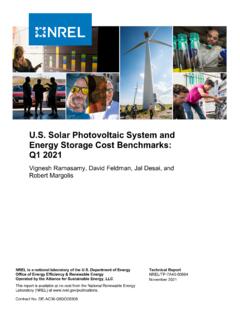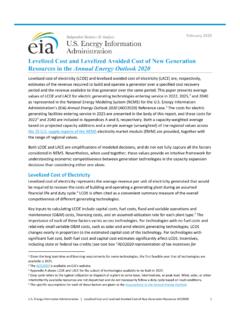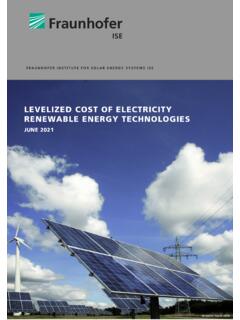Transcription of LAZARD’S LEVELIZED COST OF STORAGE …
1 LAZARD S LEVELIZED cost OF STORAGE ANALYSIS VERSION of Contents IINTRODUCTION1 IILAZARD S LEVELIZED cost OF STORAGE ANALYSIS STORAGE VALUE SNAPSHOT ANALYSIS7IV PRELIMINARY VIEWS ON LONG-DURATION STORAGE11 APPENDIXAS upplemental LCOS Analysis Materials14 BValue Snapshot Case Studies161 Value Snapshot Case Studies Snapshot Case Studies International23 IIntroductionCopyright 2021 Lazard This study has been prepared by Lazard for general informational purposes only, and it is not intended to be, and should not be construed as, financial or other advice. No part of this material may be copied, photocopied or duplicated in any form by any means or redistributed without the prior consent of Lazard s LEVELIZED cost of STORAGE ( LCOS ) analysis(1) addresses the following topics: Introduction A summary of key findings from Lazard s LCOS Lazard s LCOS analysis Overview of the operational parameters of selected energy STORAGE systems for each use case analyzed Comparative LCOS analysis for various energy STORAGE systems on a $/kW-year and $/MWh basis Energy STORAGE Value Snapshot analysis Overview of the Value Snapshot analysis and identification of selected geographies for each use case analyzed Summary results from the Value Snapshot analysis A preliminary view of long-duration STORAGE technologies Selected appendix materials Supplementary materials for Lazard s LCOS analysis, including methodology and key assumptions employed Supporting materials for the Value Snapshot analysis, including pro forma results for the and International Value Snapshot case studiesSource: Lazard and Roland Berger.
2 (1)Lazard s LCOS analysis is conducted with support from Enovation Analytics and Roland INTRODUCTION1 Copyright 2021 Lazard This study has been prepared by Lazard for general informational purposes only, and it is not intended to be, and should not be construed as, financial or other advice. No part of this material may be copied, photocopied or duplicated in any form by any means or redistributed without the prior consent of Concerns regarding the availability of Lithium-ion battery modules are increasing given ongoing supply constraints Supply constraints in commodity markets and manufacturing activities have led end-users to more seriously consider Tier 2 and Tier 3 suppliers Stationary STORAGE applications are increasingly competing with EVs over module supply as automobile manufacturers continue to shift product offerings away from traditional gasoline- and diesel-fueled vehicles Module demand from EVs is expect to increase to ~90% from ~75% of end-market demand by 2030.
3 Stationary STORAGE currently represents <5% of end market demand and is not expected to exceed 10% of the market by 2030 Pressure on legacy integrators continues to build as the industry matures Battery OEMs are moving downstream in an effort to capture more margin and expand market share, offering fully wrapped DC blocks, , STORAGE modules, container, supporting controls, fire suppression and associated cabling Concurrently, some developers are expanding in-house engineering, procurement and construction activities Legacy integrators are moving into energy management software, with many acquiring distributed energy resource management platforms Market preference has shifted significantly towards Lithium Iron Phosphate ( LFP ) vs. Nickel Manganese Cobalt ( NMC ) chemistries Industry participants increasingly prefer LFP chemistries given perceived fire safety, cost and operational advantages ( , depth of discharge).
4 The cost advantage of LFP chemistries tends to be more pronounced in shorter-duration applications Interest in longer-duration technologies continues to grow in tandem with expectations of ever greater penetration of renewable energy generation Adoption, however, remains limited given a lack of required technology and duration-specific price signals in wholesale markets ( capacity)Use Cases Hybrid applications are becoming more valuable and, by extension, widespread as grid operators begin adopting Estimated Load Carry Capability ( ELCC ) methodologies to value resources Adoption of ELCC methodologies is driving increasing deployment of hybrid resources ( , STORAGE paired with solar) to mitigate resource intermittency. STORAGE co-located with solar is expected to be most attractive in the Midwest, including in the Southwest Power Pool ( SPP ) region In ERCOT, for example, hybrid assets account for ~35% of STORAGE MW in the current interconnection queue ( , ~29% solar, ~1% wind and ~5% other) Developers are increasingly targeting markets in the Western (California), Western Europe and South America for long duration STORAGE projects as these areas experience ever greater penetration of intermittent renewable energy generation in tandem with declining dispatchable conventional generation capacitySummary of Key Findings and Observed Trends in the Energy STORAGE IndustryI INTRODUCTIONS ource.
5 LCOS surveys, Roland s LEVELIZED cost of STORAGE Analysis 2021 Lazard This study has been prepared by Lazard for general informational purposes only, and it is not intended to be, and should not be construed as, financial or other advice. No part of this material may be copied, photocopied or duplicated in any form by any means or redistributed without the prior consent of STORAGE Use Cases OverviewBy identifying and evaluating the most commonly deployed energy STORAGE applications, Lazard s LCOS analyzes the cost and value of energy STORAGE use cases on the grid and behind-the-meterUse Case DescriptionTechnologies AssessedIn-Front-of-the-MeterWholesale Large-scale energy STORAGE system designed for rapid start and precise following of dispatch signal. Variations in system discharge duration are designed to meet varying system needs ( , short-duration frequency regulation, longer-duration energy arbitrage(1)or capacity, etc.)
6 To better reflect current market trends, this report analyzes one-, two- and four-hour durations(2) Lithium Iron Phosphate Lithium Nickel Manganese Cobalt Oxide Flow Battery Vanadium Flow Battery Zinc BromineTransmission and Distribution Energy STORAGE system designed to defer or avoid transmission and/or distribution upgrades, typically placed at substations or distribution feeders controlled by utilities to provide flexible capacity while also maintaining grid stability Lithium Iron Phosphate Lithium Nickel Manganese Cobalt Oxide Flow Battery Vanadium Flow Battery Zinc BromineWholesale(PV+ STORAGE ) Energy STORAGE system designed to be paired with large solar PV facilities to better align timing of PV generation with system demand, reduce solar curtailment and provide grid support Lithium Iron Phosphate Lithium Nickel Manganese Cobalt Oxide Flow Battery Vanadium Flow Battery Zinc BromineBehind-the-MeterCommercial & Industrial (Standalone) Energy STORAGE system designed for behind-the-meter peak shaving and demand charge reduction for C&I energy users Units often configured to support multiple commercial energy management strategies and provide optionality for the system to provide grid services to a utility or the wholesale market, as appropriate in a given region Lithium Iron Phosphate Lithium Nickel Manganese Cobalt Oxide Flow Battery Vanadium Flow Battery Zinc BromineCommercial & Industrial (PV+ STORAGE )
7 Energy STORAGE system designed for behind-the-meter peak shaving and demand charge reduction services for C&I energy users Systems designed to maximize the value of the solar PV system by optimizing available revenue streams and subsidies Lithium Iron Phosphate Lithium Nickel Manganese Cobalt Oxide Flow Battery Vanadium Flow Battery Zinc BromineResidential(PV+ STORAGE ) Energy STORAGE system designed for behind-the-meter residential home use provides backup power, power quality improvements and extends usefulness of self-generation ( , PV+ STORAGE ) Regulates the power supply and smooths the quantity of electricity sold back to the grid from distributed PV applications Lithium Iron Phosphate Lithium Nickel Manganese Cobalt Oxide123456II LAZARD S LEVELIZED cost OF STORAGE ANALYSIS : Industry interviews, Lazard and Roland Berger. Note:Use case numbering shown above serves as an identifier for the corresponding individual use cases discussed on subsequent pages.
8 (1)For the purposes of this analysis, energy arbitrage in the context of STORAGE systems paired with solar PV includes revenue streams associated with the sale of excess generation from the solar PV system, as appropriate, for a given use case.(2)The Value Snapshot analysis only evaluates the four-hour wholesale use case. 3 Copyright 2021 Lazard This study has been prepared by Lazard for general informational purposes only, and it is not intended to be, and should not be construed as, financial or other advice. No part of this material may be copied, photocopied or duplicated in any form by any means or redistributed without the prior consent of STORAGE Use Cases Illustrative Operational ParametersII LAZARD S LEVELIZED cost OF STORAGE ANALYSIS s LCOS evaluates six commonly deployed use cases for energy STORAGE by identifying illustrative operational parameters(1) Energy STORAGE systems may also be configured to support combined/ stacked use casesProject Life (Years) STORAGE (MW)(3)Solar PV(MW)Battery Degradation (per annum) STORAGE Duration(Hours)Nameplate Capacity(MWh)(4)90% DOD Cycles/ Day(5)Days/Year(6)AnnualMWh ProjectMWhIn-Front-of-the-MeterWholesale (7) ,500630, ,0001,260, ,0002,520,000 Transmission and Distribution(7) ,35027,000 Wholesale(PV+ STORAGE )(7) ,0001,260,000 Behind-the-MeterCommercial &Industrial (Standalone) ,500 Commercial &Industrial (PV+ STORAGE )(7) ,600 Residential(PV+ STORAGE )
9 Usable Energy (2)123456 ABFCEDx =BCGx x =DEFHx =AGSource: Lazard and Roland Berger. Note:Operational parameters presented are applied to Value Snapshots and LCOS calculations. Annual and Project MWh presented are illustrative. Annual battery output in the Value Snapshot analysis depends on a participation optimization analysis and may vary from the representative project MWh by use case.(1)The six use cases below represent illustrative current and contemplated energy STORAGE applications and are derived from Industry survey data.(2)Usable energy indicates energy stored and available to be dispatched from the battery.(3)Indicates power rating of system ( , system size).(4)Indicates total battery energy content on a single, 100% charge, or usable energy. Usable energy divided by power rating (in MW) reflects hourly duration of system. This analysis reflects common practice in the market whereby batteries are upsized in year one to 110% of nameplate capacity ( , a 100 MWh battery actually begins project life with 110 MWh).
10 (5) DOD denotes depth of battery discharge ( , the percent of the battery s energy content that is discharged). Depth of discharge of 90% indicates that a fully charged battery discharges 90% of its energy. To preserve battery longevity, this analysis assumes that the battery never charges over 95%, or discharges below 5%, of its usable energy.(6)Indicates number of days of system operation per calendar year. (7)Augmented to nameplate MWh capacity in year 11 of 2021 Lazard This study has been prepared by Lazard for general informational purposes only, and it is not intended to be, and should not be construed as, financial or other advice. No part of this material may be copied, photocopied or duplicated in any form by any means or redistributed without the prior consent of LEVELIZED cost of STORAGE Comparison Capacity ($/kW-year)II LAZARD S LEVELIZED cost OF STORAGE ANALYSIS : Lazard :Here and throughout this presentation, unless otherwise indicated, analysis assumes a capital structure consisting of 20% debt at an 8% interest rate and 80% equity at a 12% cost of equity.


![[Logo To Come] - Lazard](/cache/preview/b/e/f/6/9/1/8/9/thumb-bef691898073c3588972f362b9ac0cd8.jpg)














